Note: If an image ever fails to appear - refresh your page, it really is there
Flags of the United States of America
Governmental Flags of the United States of America
Presidents Cabinet and Cabinet-level officers

President's Flag
|
Flag of the President of the United States
This flag is flown for the President of the United States of America, the highest elected official and chief executive of the United States. He is also considered the Commander-in-Chief by all of the Military forces of the United States and heads the Executive Branch of the government. His chief advisors are called Secretaries and are members of his "Cabinet." The President appoints the members of his cabinet, with approval of Congress, and they, in turn, head the various departments and agencies of the government for the President.
His flag (first used in 1877) shows the "Seal of the President" (approved in 1945), which was based on the Great Seal of the United States, placed on a blue field surrounded by 50 stars. The only changes since 1945 were in 1959 and 1960, which added 49th and 50th stars to the circle following the admissions of Alaska and Hawaii as states. Gold fringes are often added to indoor variants of the Presidential flag. |
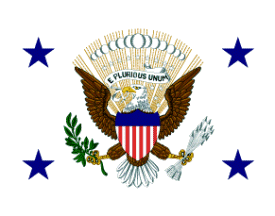
Vice President's Flag
|
Flag of the Vice President of the United States
The Vice President of the United States is elected as the running mate of the President of the United States by the Electoral College. The make-up of the Electoral College is based on the outcome of the public vote in the Presidential elections. He, like the President, serves a four-year term and becomes the President if the President's office becomes vacant (due to the death, resignation, or medical impairment of the President). The Vice President is also seated President of the United States Senate, but only allowed to vote in the Senate to break a tied vote.
The Flag of the Vice President of the United States consists of the Vice Presidential Coat-of-Arms centered on a white background, with a dark blue star in each corner. Although a similar design was first used in 1936, the current flag was designed during President Gerald Ford's administration and dates from 1975. The indoor variant of the Vice-President's flag sometimes has an additional blue fringe added.
|
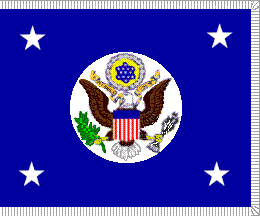
Secretary of Defense Flag
|
Flag of the Secretary of State
The Secretary of State, appointed by the President with the advice and consent of the Senate, is the President's chief foreign affairs adviser and the first cabinet position established by President George Washington in 1789 (which demonstrates how [rarely] some things are more important than money). The Secretary carries out the President's foreign policies through the State Department and the Foreign Service of the United States.
The Flag of the Secretary of State was first authorized by President Wilson in 1920. The occasion was the impending departure of the Secretary on a visit to South America as the President's special representative, during which the Secretary would be traveling by U.S. Navy ship. The flag was blue with a rendition of the U.S. coat-of-arms in gold, flanked by two gold stars. This original flag was redesigned in 1933 under President Roosevelt´s administration by the present flag.
|
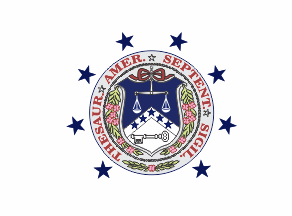
Secretary of Treasury 1887
|
Flag of the Secretary of Treasury 1887-1915
Although the position was the second cabinet position officially started by George Washington in 1789, the history of the Department of the Treasury began earlier in the turmoil of the American Revolution, when the Continental Congress at Philadelphia deliberated the crucial issue of financing a war of independence against Great Britain. Michael Hillegas was first called Treasurer of the United States on May 14, 1777.
The Treasury Office was reorganized three times between 1778 and 1781. In 1789, Congress created a permanent institution for the management of government finances and Washington made it a cabinet post. Alexander Hamilton served as the first Secretary of the Treasury from 1789 to 1795.
|
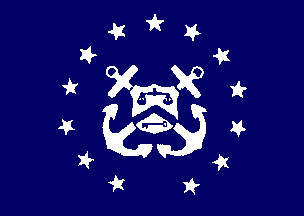
Secretary of Treasury 1915
|
Flag of the Secretary of Treasury 1915-1963
The current Flag of Rank for the Secretary of the Treasury has a background of "old glory" blue, sometimes fringed in golden yellow. The shield background, crossed anchors outside the shield, and 13 crested stars are all in white. Inside the shield, the balances above the chevron, the chevron, and the traditional Treasury key beneath the chevron are all in old glory blue.
The current flag of the Secretary of the Treasury does not seem to have the usual four stars in the corners.
|
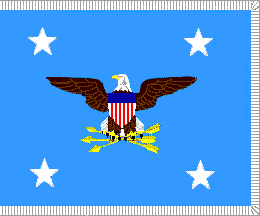
Secretary of Defense Flag
|
Flag of the United States Secretary of Defense
The Secretary of Defense is the principal defense policy adviser to the President and is responsible for the formulation of general defense policy and policy related to all matters of direct concern to the Department of Defense, and for the execution of approved policy. Under the direction of the President, the Secretary exercises authority, direction and control over the Department of Defense. The Secretary of Defense is a member of the President's Cabinet and of the National Security Council.
The flag of the Secretary of Defense is "medium blue" with a centered Department seal and four white stars that dates from 1947. Under the Secretary of Defense the three branches of the armed forces are represented by the Secretary of the Army, the Secretary of the Navy, and the Secretary of the Air Force.
|
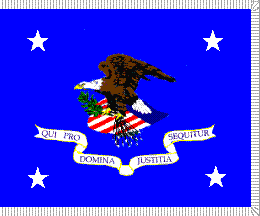
Attorney General's Flag
|
Flag of the United States Attorney General
The Attorney General is the head of the Department of Justice and chief law enforcement officer of the Federal Government. The Attorney General represents the United States in legal matters and gives advice and opinions to the President and to the heads of the executive departments of the Government on legal matters. The Judiciary Act was passed by Congress and signed by President George Washington in 1789, making the Attorney General position the fourth created by Congress of those positions that have come to be known as Cabinet level positions.
The flag is blue with the Department of Justice seal centered on it and a white star in each corner. Below the shield is a scroll inscribed Qui pro domina Justitia sequitur (Who prosecutes on behalf of our lady Justice).
|
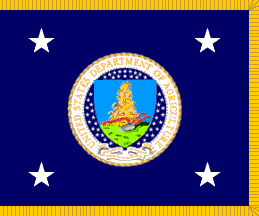
Secretary of Agriculture Flag
|
Flag of the Secretary of Agriculture
The United States Secretary of Agriculture is the head of the United States Department of Agriculture and a member of the President's Cabinet. The Agriculture Department in turn supervises the activities of the United States Forest Service, the United States Food Safety and Inspection Service, the Food Stamp Program, and the United States Cooperative State Research, Education, and Extension Service, to name a few.
The flag of the Secretary of Agriculture is dark blue with the seal of the department in the center and a white star in each corner. This flag was adopted in 1941.
|
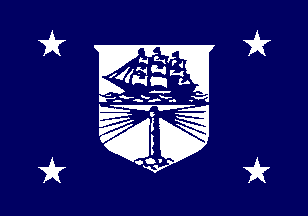
Secretary of Commerce Flag
|
Flag of the Secretary of Commerce
The United States Secretary of Commerce is the head of the United States Department of Commerce. His job is to help the President in formulating policy concerning business and industry. Until 1913, there was one Secretary of Commerce and Labor, uniting this department with the Department of Labor, which is now headed by a separate Secretary of Labor.
The Flag of the Secretary of Commerce is blue with the Departmental shield in white with blue charges (in chief a full-rigged ship under sail and in base a lighthouse); in each corner a white star. It was approved for use in 1986.
|
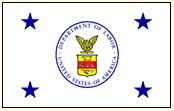
Secretary of Labor Flag
|
Flag of the Secretary of Labor 1915-1960
The United States Secretary of Labor is the head of the Department of Labor who exercises control over the department and enforces and suggests laws involving unions, the workplace, and all other issues involving any form of business-person controversies. Previously there was one Secretary of Commerce and Labor, uniting this department with the Department of Commerce, which is headed by a separate Secretary of Commerce. The first Secretary of Labor was appointed in 1913 under President Woodrow Wilson.
The Flag of the Secretary of Labor was white with the Departmental shield in white and blue and in each corner a blue star.
|
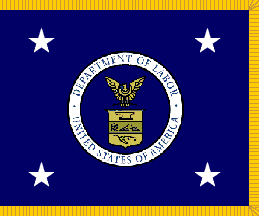
Secretary of Labor Flag
|
Flag of the Secretary of Labor 1960-
The Flag of the Secretary of Labor is blue with the Departmental shield in white with blue charges and in each corner a white star.
|
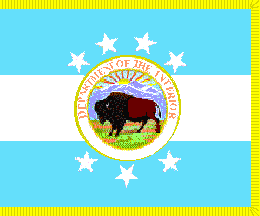
SOI Flag 1917-1934
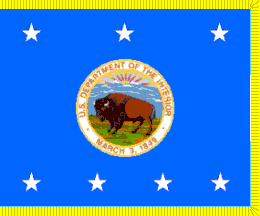
SOI Flag since 1934
|
Flag of the Secretary of the Interior
The United States Secretary of the Interior is the head of the United States Department of the Interior. The U.S. Department of the Interior, established in 1849, protects America’s natural resources and heritage. The Secretary also serves on and appoints the private citizens on the National Park Foundation board.
The current flag (1934 version) of the Secretary has a solid light blue background with the Department of the Interior seal centered and 7 white stars arranged in 2 straight horizontal rows with 3 above the seal and 4 below the seal. The seven stars represent the seven principal subdivisions of the department when this flag was adopted: Bureau of Indian Affairs, Bureau of Reclamation, National Park Service, Bureau of Land Management, Bureau of Mines, Geological Survey, and Fish and Wildlife Service. The flag when used indoors has a Gold fringe and a cord and tassels, useually with a spread eagle finial on the pole. Also exists a vessel flag, 22 x 32 inches without fringe, and an automobile flag, 18 x 26 inches without fringe.
The former flag (1917 version) was used until the mid-1930s, a horizontal triband, light blue-white-light blue, with the seal on the center surrounded by the seven white stars, three above and four below the seal, arranged in arcs. Note that the seal at the time differed from that currently in use, lacking the date of the department's establishment.
|
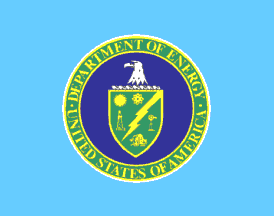
SOE Flag
|
Flag of the Secretary of Energy
The United States Secretary of Energy is the head of the US Department of Energy and a member of the President's Cabinet. The position was formed on October 1, 1977 by President Jimmy Carter. The United States Secretary of Energy is charged with helping the President implement policies to invest in clean energy, including nuclear and other alternative means, and to reduce the United States dependence on foreign oil. The Department of Energy is also charged with the difficult jobs of radioactive waste disposal and maintenance of environmental quality.
The flag of the Secretary of Energy has a pale blue field with the seal of the department in the center. The seal is surrounded by a very narrow white fimbriation, and doesn't seem to have a white star in each corner. This date of this flag's adoption is unclear.
|
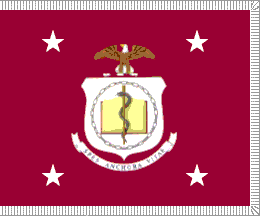
SHEW Flag
|
Flag of the Secretary of Health, Education and Welfare 1953-1980
President Harding first proposed a Department of Education and Welfare in 1923, but for various reasons it was not done until 1953 by President Eisenhower and the Secretary of Health, Education and Welfare became an official Cabinet post. In 1979, the Department of Health, Education (HEW), and Welfare was renamed the Department of Health and Human Services (HHS), and its former education functions transferred to the newly formed Department of Education.
|
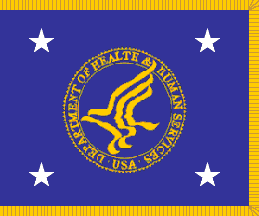
SHHS Flag
|
Flag of the Secretary of Health and Human Services 1980
The United States Secretary of Health and Human Services is the head of the United States Department of Health and Human Services, and is a member of the President's Cabinet. The Secretary advises the President on national Health issues. This includes advising the President on wide variety of Health matters including income security programs, and after the attacks of 9/11 (and subsequent anthrax attacks), includes a special role in the War on Terrorism. The office was formerly known as the Secretary of Health, Education, and Welfare.
|
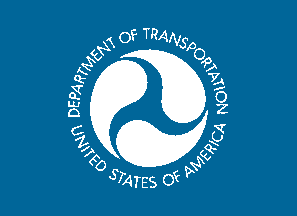
SOT Flag
|
Flag of the Secretary of Transportation
According to the DOT website, "The Office of the Secretary (OST) oversees the formulation of national transportation policy and promotes intermodal transportation. Other responsibilities range from negotiation and implementation of international transportation agreements, assuring the fitness of US airlines, enforcing airline consumer protection regulations, issuance of regulations to prevent alcohol and illegal drug misuse in transportation systems and preparing transportation legislation." The Secretary of Transportation is the Cabinet member who advises the President on Transportation issues and runs the DOT.
|

HUD Flag
|
Flag of the Secretary of Housing and Urban Development
The United States Secretary of Housing and Urban Development is the head of the US Department of Housing and Urban Development, and a member of the President's Cabinet. The position was created with the formation of the Department of Housing and Urban Development in 1965 by President Lyndon B. Johnson. HUD's goal is "to increase home ownership, support community development and increase access to affordable housing free from discrimination."
Thus far the Secretary of Housing and Urban Development has only been seen with the standard white HUD flag.
|
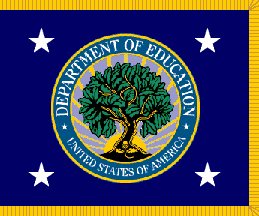
Secretary of Education Flag
|
Flag of the Secretary of Education 1980
The United States Secretary of Education is the head of the Department of Education and a member of the President's Cabinet. The United States Secretary of Education advises the President on Education policy and is, in turn, advised by the National Advisory Committee on Institutional Quality and Integrity on "matters related to accreditation and to the eligibility and certification process for institutions of higher education." The Department of Education became its own department after it was divided from the Department of Health, Education, and Welfare in 1980. ED's mission is to promote student achievement and preparation for global competitiveness by fostering educational excellence and ensuring equal access.
|

SVA Flag
|
Flag of the Secretary of Veterans Affairs
The United States Secretary of Veterans' Affairs is the head of the United States Department of Veterans Affairs, a department concerned with veterans' benefits and related matters. The Secretary is a member of the Cabinet and advises the President on veteran matters. Thus far all appointees have been United States military veterans.
|
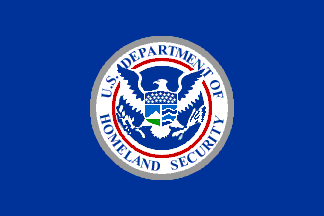
Homeland Security Flag
|
Flag of the Secretary of Homeland Security
The United States Secretary of Homeland Security is the head of the United States Department of Homeland Security, the body concerned with protecting the American homeland and the safety of American citizens. The Department and position was created by the Homeland Security Act following the terrorist attacks of September 11, 2001.
The seal of HLS is centered on its flag. A white American eagle appears in the circular shield with outstretched wings break surrounded be an outer white ring that contains the words "U.S. DEPARTMENT OF" in the top half and "HOMELAND SECURITY" in the bottom half. In the tradition of the Great Seal of the United States, the eagle's talon on the left holds an olive branch with 13 leaves and 13 seeds while the eagle's talon on the right grasps 13 arrows. Thus far the Secretary of Homeland Security seems to be using this standard department flag.
|
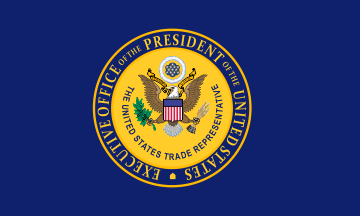
USTR Flag
|
Flag of the United States Trade Representative
The head of USTR is the U.S. Trade Representative, a Cabinet member who serves as the president’s principal trade advisor, negotiator, and spokesperson on trade issues. The Office of the U.S. Trade Representative (USTR) is responsible for developing and coordinating U.S. international trade, commodity, and direct investment policy, and overseeing negotiations with other countries.
|
Flags of the Executive Departments
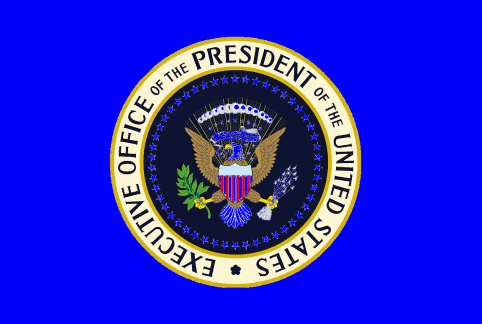
EOP Flag
|
Executive Office of the President
The Executive Office of the President (EOP) consists of the immediate staff of the President of the United States, as well as multiple levels of support staff reporting to the President. The EOP was created in 1939 and has grown to include a large number of policy experts in a large variety of fields.
The EOP is headed by the White House Chief of Staff. Under the Chief of Staff are the Assistants to the President, directly below them are the Deputy Assistants to the President, and then the Special Assistants to the President. There are many variants of this basic flag design used for the different departments and divisions of the EOP.
|
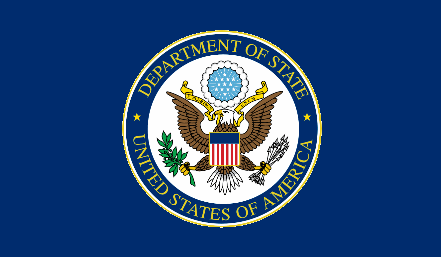
State Department Flag
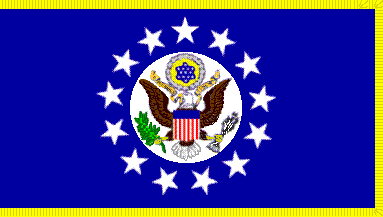
US Ambassador's Flag
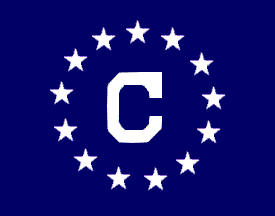
US Consular Officer 1903
(boat or car flag)

US Foriegn Service Officer
(boat or car flag)
|
Department of State
The United States Department of State (State Department or DOS), is the United States executive department responsible for all international relations of the United States federal government, equivalent to the foreign ministries of other countries. The Department was created in 1789 and was the first executive department established. It is headed by the Secretary of State, a member of the President's Cabinet. For years the Department of State simply used the Flag of the United States as its department flag, however, in recent years a special State Department house flag has also been seen, along with special individual Ambassador and Minister flags.
Ambassadors are nominated by the President and confirmed by the Senate. An ambassador can be appointed during a recess of the Senate, but can serve only the end of the next session of Congress unless subsequently confirmed by the Senate. As embassies fall within the Department of State, ambassadors answer to the Secretary of State, but serve "at the pleasure of the President," which means that they can be dismissed at any time.
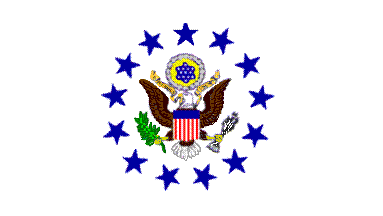 US Chief of Mission to the UN The Department of State's Foreign Affairs Manual provides distinctive personal flags for ambassadors and other chiefs of mission accredited to sovereign states, similar to that of the Secretary of State, but with the disk bearing the US Coat-of-Arms surrounded by a ring of 13 white stars. The United States Mission to the United Nations also uses a special flag. The Mission Chief is always political and appointed by the President of the United States. Since 1946, the Department of State has authorized the use of an automobile flag for accredited foreign service officers representing the chief of mission at important ceremonial or official functions.
There is also a flag used to indicate the presence of an American consular officer aboard a boat in foreign waters. A version with a gold fringe, cord, and tassels, has since been established for display in specified locations at American consulates abroad. It can also be used as an automobile flag by the principal officer of a consular post. |
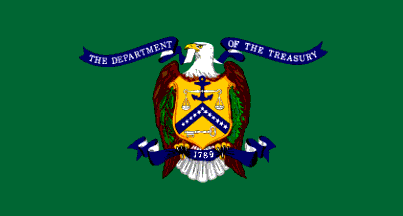
DOT Flag
|
United States Department of Treasury
The management of the money resources of the United States has always been the primary function of the Department of the Treasury. Though formally established as an executive department by the First Session of Congress in 1789, many functions of the Department of the Treasury were being carried out even before the signing of the Declaration of Independence thirteen years earlier. Over the decades, the functions of the Department have expanded and grown more sophisticated to meet the needs of a developing nation. Today, the Department of the Treasury remains the premier financial institution of the United States with a full-time agenda of accounting, revenue collection, money production, and economic policy formulation.
|
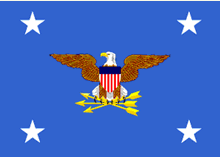
Department of Defense Flag
|
Department of Defense 1947-
The War Department was established in 1789, and was the precursor to what is now the Department of Defense. The decision to unify the different services under one Department was made in 1947. This establishment would replace the War Department (which converted to the Department of the Army). The three military branches, Army, Navy, and Air Force, were placed under the direct control of the new Secretary of Defense. In 1949, cabinet-level status was withdrawn from the three service secretaries (Army, Navy, and Air Force) and placed under the Department of Defense.
This flag is identical to the one used by the Secretary of Defense.
|
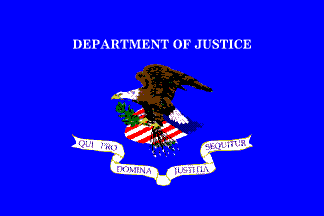
DOJ Flag
|
Department of Justice
The Department of Justice traces its beginning to the First Congress meeting in New York in 1789. The Judiciary Act of 1789 created the Office of the Attorney General which evolved over the years into the head of the Department of Justice and chief law enforcement officer of the Federal Government.
|
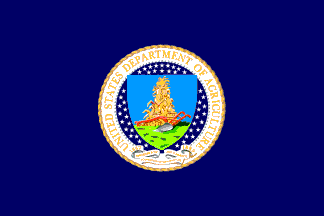
Department of Agriculture Flag
|
Department of Agriculture
The United States Department of Agriculture (informally the Agriculture Department or USDA) is the United States federal executive department responsible for developing and executing U.S. federal government policy on farming, agriculture, and food. It aims to meet the needs of farmers and ranchers, promote agricultural trade and production, work to assure food safety, protect natural resources, foster rural communities and end hunger in the United States and abroad.
The Department of Agriculture flag is dark blue with the departmental seal, which depicts a blue shield with a green mound in the base, and thereon a shock of corn (maize) and a plow. The shield is set against a dark blue circle with 44 white stars, representing the states of the Union at the time the seal was adopted. Below the shield is a scroll inscribed "1862 Agriculture is the foundation of manufacture and commerce 1889," 1862 being the date the department was originally established and 1889 the date it was given cabinet rank. Surrounding the shield is a ring with the name of the department in gold letters.
|
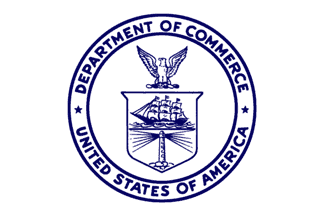
DOC Flag
|
Department of Commerce
The United States Department of Commerce main purposes are to promote job creation, economic growth, sustainable development and improved standards of living for all Americans by working in partnership with businesses, universities, communities and our nation’s workers. The department touches the daily lives of the American people in many ways, with a wide range of responsibilities in the areas of trade, economic development, technology, entrepreneurship and business development, environmental stewardship, and statistical research and analysis.
The United States Department of Commerce is a Cabinet department of the United States government and was originally created as the "United States Department of Commerce and Labor" in 1903. It was subsequently renamed to the "Department of Commerce" in 1913, and its bureaus and agencies specializing in labor were transferred to the new Department of Labor at that time.
|
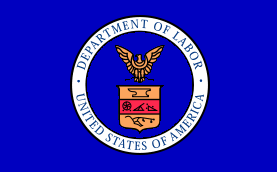
Department of Labor Flag
|
Department of Labor 1915-1960
In 1915 the Department of Labor was formed with the split of the old "United States Department of Commerce and Labor" when the bureaus and agencies specializing in labor were transferred to the newly formed Department of Labor and placed under the President's Secretary of Labor.
|
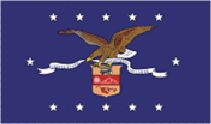
Department of Labor Flag
|
Department of Labor since 1960
The United States Department of Labor is an executive Cabinet department of the United States government and headed by the United States Secretary of Labor. The DOL is "responsible for occupational safety, wage and hour standards, unemployment insurance benefits, re-employment services, and some economic statistics. Many U.S. states also have such departments."
The Flag of the United States Department of Labor has the Department shield centered on a blue field.
|
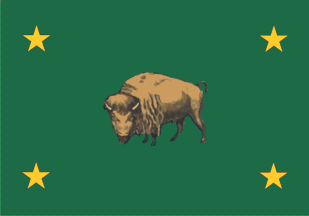
DOI Flag pre-1917
|
Department of the Interior pre-1917
The Interior Department oversees the Bureau of Land Management, the United States Geological Survey, and the National Park Service. It's responsibilities include the census, regulation of territorial governments, exploration of the western wilderness, and strangely enough, management of the District of Columbia's jail and water system.
|
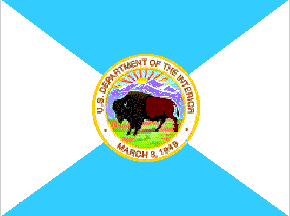
DOI Flag 2001
|
Department of the Interior 2001
The current flag of the Department of the Interior is divided by two diagonal lines, light blue in the upper and lower quadrants and white in the hoist and fly, with the departmental seal in color on the center. The seal depicts a bison standing on a prairie before a mountain range.
|
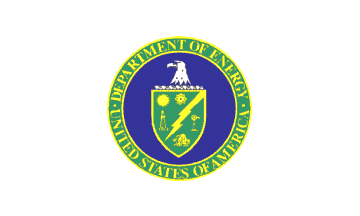
DOE Flag
|
Department of Energy
The Department of Energy was formed in 1977 by President Jimmy Carter with the signing of the Department of Energy Organization Act in October of that year. The mission of the Energy Department is to ensure America’s security and prosperity by addressing its energy, environmental and nuclear challenges through transformative science and technology solutions. The Energy Department is also charged with the difficult jobs of developing clean energy, including nuclear and other alternative means, and reducing the United States dependence on foreign oil, radioactive waste disposal and maintenance of environmental quality.
|
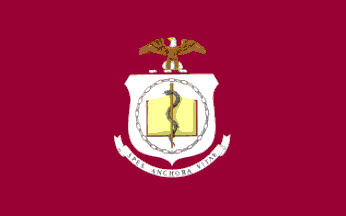
HEW Flag
|
Department of Health, Education and Welfare 1953-1980
RenThe United States Department of Health, Education, and Welfare (also known as HEW) was a cabinet-level department of the United States government from 1953 until 1979. It was administered by the United States Secretary of Health, Education, and Welfare. In 1979, a separate Department of Education (ED) was created from this department, and HEW was renamed as the Department of Health and Human Services (HHS) in 1980.
|

HHS Flag
|
Department of Health and Human Services 1980
The United States Department of Health and Human Services (HHS), is a Cabinet department of the United States government with the goal of protecting the health of all Americans and providing essential human services. Its motto is "Improving the health, safety, and well-being of America."
The HHS also has jurisdiction over Medicare and Medicaid,
|
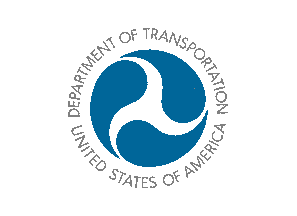
DOT Flag
|
Department of Transportation
The Department of Transportation was established by an act of Congress in 1966 with a mission to "Serve the United States by ensuring a fast, safe, efficient, accessible and convenient transportation system that meets...(the)...vital national interests and enhances the quality of life of the American people, today and into the future." The United States Secretary of Transportation is the head of the United States Department of Transportation, and a member of the President's Cabinet.
|

HUD Flag
|
Department of Housing and Urban Development
The United States Department of Housing and Urban Development, also known as HUD, is a Cabinet department in the Executive branch of the United States federal government. Although its beginnings were in the House and Home Financing Agency, it was founded as a Cabinet department in 1965, as part of the "Great Society" program of President Lyndon Johnson. HUD’s mission is to create strong, sustainable, inclusive communities and quality affordable homes for all. HUD is working to strengthen the housing market to bolster the economy and protect consumers; meet the need for quality affordable rental homes: utilize housing as a platform for improving quality of life; build inclusive and sustainable communities free from discrimination; and transform the way HUD does business.
|
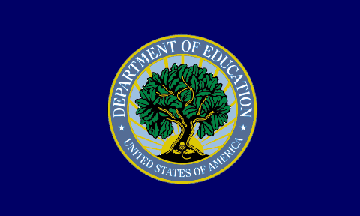
Department of Education Flag
|
Department of Education 1980
The United States Department of Education was created in 1980 by combining offices from several federal agencies. The Secretary of Education, a member of the President's Cabinet, runs the department whose goals include: Establishing policies on federal financial aid for education, and distributing as well as monitoring those funds, collecting data on America's schools and disseminating research, focusing national attention on key educational issues, and prohibiting discrimination and ensuring equal access to education.
The Flag of the United States Department of Education has the Department shield centered on a blue field.
|

DOVA Flag
|
Department of Veterans Affairs
The United States Secretary of Veterans' Affairs is the head of the United States Department of Veterans Affairs, the department concerned with veterans' benefits and related matters. The Secretary is a member of the Cabinet.
|

DHS Flag
|
Department of Homeland Security
The Department of Homeland Security was created by the Homeland Security Act following the terrorist attacks of September 11, 2001. The new department took over leadership of various existing components of other cabinet departments because of their role in homeland security, such as the Coast Guard, Federal Protective Service, U.S. Customs and Border Protection, the Border Patrol, Secret Service, and the Federal Emergency Management Agency (FEMA).
|
Flags of Federal Bureau, Offices and Agencies
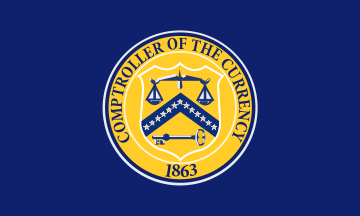
OCC Flag
|
Comptroller of the Currency
The Office of the Comptroller of the Currency was established in 1863 as an independent bureau of the U.S. Department of the Treasury. The President, with the advice and consent of the U.S. Senate, appoints the Comptroller to head the agency for a five-year term. The Comptroller also is a director of the Federal Deposit Insurance Corporation. The OCC's primary mission is to charter, regulate, and supervise all national banks and federal savings associations. We also supervise the federal branches and agencies of foreign banks. Headquartered in Washington, D.C., the OCC has four district offices plus an office in London to supervise the international activities of national banks.
|
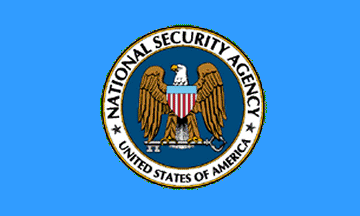
NSA/CSS Flag
|
National Security Agency
The National Security Agency/Central Security Service (NSA/CSS) is the cryptologic (code breaking) intelligence agency of the United States Department of Defense. It is responsible for the collection and analysis of foreign intelligence and communications and to protecting U.S. government communications and information systems from foreign intelligence gathering organizations.
|
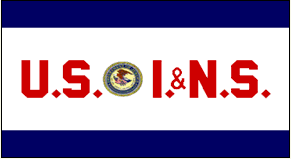
ICE Ensign 2003
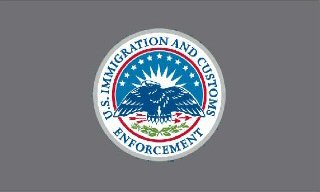
ICE Flag 2013
|
United States Immigration and Customs Enforcement Agency 2003
U.S. Immigration and Customs Enforcement is the principal investigative arm of the U.S. Department of Homeland Security (DHS) and the second largest investigative agency in the federal government. Created in 2003 through a merger of the investigative and interior enforcement elements of the U.S. Customs Service and the Immigration and Naturalization Service, ICE now has more than 20,000 employees in offices in all 50 states and 47 foreign countries.
The Special Agents of ICE, known as HSI (Homeland Security Investigations), use broad legal authority to investigate and fight anything that threaten the national security of the United States including human rights violations, human smuggling, art theft, human trafficking, drug smuggling, arms trafficking, smuggling (including weapons of mass destruction), immigration crimes, gang investigations; financial crimes including money laundering, bulk cash smuggling, financial fraud, money laundering, terrorism, computer crimes, child pornography over the Internet, intellectual property rights crimes, cultural property crimes (antiquities and art), and import/export enforcement issues. HSI special agents also provide security details for VIPs, assist the secret service and US Marshalls, and work with the witness protection program.
|
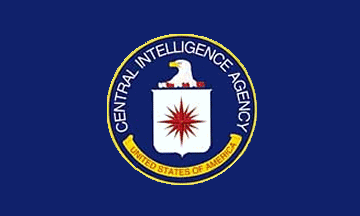
CIA Flag
|
Central Intelligence Agency
The Central Intelligence Agency (CIA) is an independent US Government agency responsible for providing national security intelligence to senior US policymakers. The United States has carried out intelligence activities since the days of George Washington, but only since World War II have they been coordinated on a government-wide basis. After the US entered World War II in 1942, the task of gathering intelligence fell to the Office of Strategic Services (OSS), the forerunner of the CIA. After World War II, however, the OSS was abolished along with many other war agencies and its functions were transferred to the State and War Departments. It did not take long before President Truman recognized the need for a postwar, centralized intelligence organization. To make a fully functional intelligence office, Truman signed the National Security Act of 1947 establishing the CIA.
|
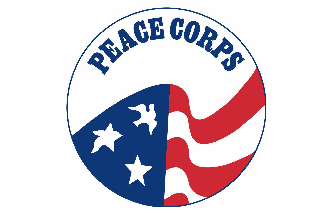
Peace Corps Flag
|
United States Peace Corps
The Peace Corps is an American volunteer program run by the United States Government whosed stated mission is providing technical assistance; helping people outside the United States to understand US culture; and helping Americans to understand the cultures of other countries. The program was established in 1961 by President John F. Kennedy as part of the "New Frontier" policies "to promote world peace and friendship through a Peace Corps, which shall make available to interested countries and areas men and women of the United States qualified for service abroad and willing to serve, under conditions of hardship if necessary, to help the peoples of such countries and areas in meeting their needs for trained manpower." Since 1961, hundreds of thousands of American volunteers have joined the Peace Corps and have served in over 140 different countries.
|
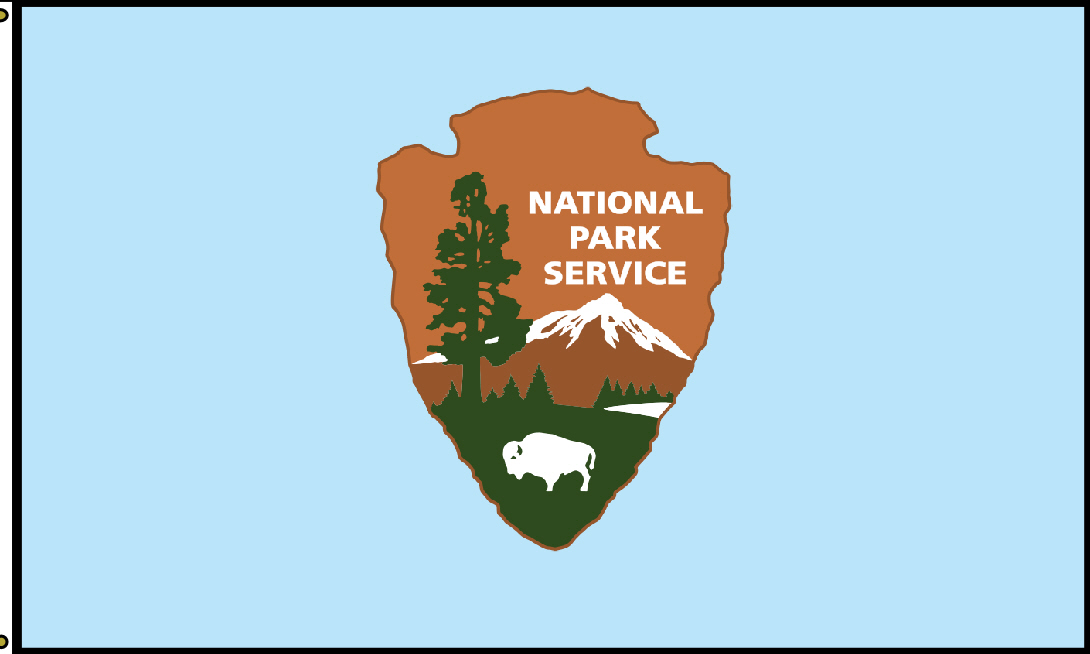
NPS Flag
|
National Parks Service
The National Park Service (NPS) is the U.S. federal agency that manages all national parks and many of the national monuments for the American public. It is part of the United States Department of the Interior, and operates under direction of the Secretary of the Interior. It was created in 1916.
|

BLM Flag
|
Bureau of Land Management
The Bureau of Land Management (BLM) is the agency of the United States Department of the Interior which administers America's public lands. The BLM's mission is to sustain the health, diversity and productivity of the public lands for the use and enjoyment of present and future generations.
The BLM began with the Land Ordinance of 1785 and the Northwest Ordinance of 1787. These laws required that public lands be surveyed with the goal of public settlement. As the country grew, so did it's public lands and in 1812, the United States Congress directed that a General Land Office be established in the Department of the Treasury to oversee the disposition of these federal lands. It is from these roots the modern BLM sprang and in 1946, the General Land Office became part of the larger Bureau of Land Management and placed under the direction of the Department of the Interior.
|
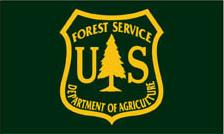
USFS Flag
|
United States Forest Service
The United States Forest Service is the agency of the United States Department of Agriculture that administers the nation's 155 national forests and 20 national grasslands. In 1876, Congress created the office of Special Agent in the Department of Agriculture to assess the quality and conditions of forests in the United States. In 1881, the office was expanded and renamed the Division of Forestry and in 1901, renamed the Bureau of Forestry. The Transfer Act of 1905 transferred the management of forest reserves from the General Land Office of the Interior Department to the Bureau of Forestry, now named the United States Forest Service. Gifford Pinchot was the first Chief Forester of the United States Forest Service in the administration of President Theodore Roosevelt.
|
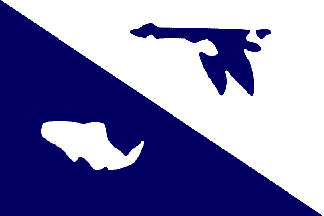
DFW Flag
|
United States Fish and Wildlife Service
The U.S. Fish and Wildlife Service is a bureau of the Department of the Interior established in 1939 by merging the Department of Agriculture's Bureau of Biological Survey and the Department of Commerce's Bureau of Fisheries. The USFWS administers a series of national wildlife refuges and ensures compliance with federal laws protecting migratory birds, fish, and other wildlife. In the latter capacity, USFWS inspectors are present at U.S. ports of entry to enforce laws against smuggling of endangered and threatened species of wildlife.
Starting in 1940, the service used a flag divided diagonally, dark blue and white, with the silhouettes of a flying Canada goose and a jumping trout. Unfortunately, this attractive and distinctive design has since been replaced with an uninspired design featuring a cluttered seal and a great deal of writing on a plain white background.
|

EPA Flag
|
Environmental Protection Agency
The United States Environmental Protection Agency (EPA or sometimes USEPA) was begun in 1970 as an agency of the federal government of the United States charged with protecting human health and the environment. Born in the wake of elevated concern about environmental pollution, the EPA was established to consolidate in one agency a variety of federal research, monitoring, standard-setting and enforcement activities to ensure environmental protection. Since its inception, EPA has been working for a cleaner, healthier environment for the American people. As psrt of its efforts the EPA operates two major research vessels, the 250-ton OSV Peter W. Anderson in the Atlantic and the 266-ton RV Lake Guardian on the Great Lakes, as well as a number of smaller research vessels and boats.
The EPA flag is white with the agency seal on the center and is occasionally flown by vessels of the EPA fleet.
|
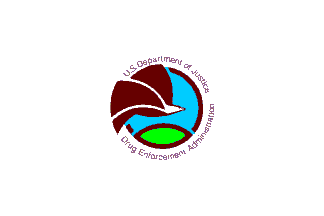
DEA Flag
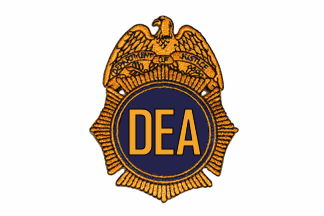
|
United States Drug Enforcement Administration
The Drug Enforcement Administration (DEA) is a federal law enforcement agency under the United States Department of Justice, tasked with combating drug smuggling and use within the United States. Not only is the DEA the lead agency for domestic enforcement of the Controlled Substances Act, sharing concurrent jurisdiction with the Federal Bureau of Investigation (FBI) and Immigration and Customs Enforcement (ICE), it also has sole responsibility for coordinating and pursuing U.S. drug investigations abroad.
|
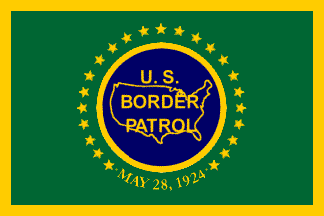
USBP Flag
|
United States Border Patrol 1999
The United States Border Patrol is a federal law enforcement agency within U.S. Customs and Border Protection (CBP), a component of the Department of Homeland Security (DHS). It is an agency in the Department of Homeland Security that enforces laws and regulations for the admission of foreign-born persons to the United States codified in the Immigration and Nationality Act. U.S. Customs and Border Protection has more sworn, armed law enforcement officers than any other agency in the U.S. federal government.
|
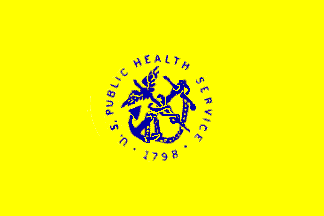
PHS Flag
|
United States Public Health Service
The Public Health Service Act of 1944 structured the United States Public Health Service (PHS) as the primary division of the Department of Health, Education and Welfare (HEW), which later became the United States Department of Health and Human Services. The PHS comprises all Agency Divisions of Health and Human Services and the Commissioned Corps. The Assistant Secretary for Health (ASH) oversees the PHS and the United States Public Health Service Commissioned Corps.
|

PHS Flag
|
United States Public Health and Marine Hospital Service 1912
As immigration increased dramatically in the late nineteenth century, the Federal Government took over the processing of immigrants from the states, beginning in 1891. The Marine Hospital Service was assigned the responsibility for the medical inspection of arriving immigrants at sites such as Ellis Island in New York. Because of the broadening responsibilities of the Service, its name was changed in 1902 to the Public Health and Marine Hospital Service, and again in 1912 to just the Public Health Service. As the century progressed, PHS commissioned officers served their country by controlling the spread of contagious diseases such as smallpox and yellow fever, conducting important biomedical research, regulating the food and drug supply, providing health care to underserved groups, supplying medical assistance in the aftermath of disasters, and in numerous other ways.
|
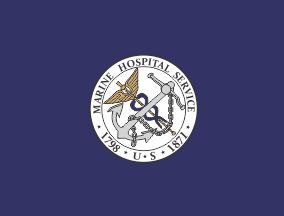
PHS Flag
|
United States Marine Hospital Service
A reorganization in 1870 converted the loose network of locally controlled hospitals into a centrally controlled Marine Hospital Service, with its headquarters in Washington, D.C. The position of Supervising Surgeon (later Surgeon General) was created to administer the Service, and John Maynard Woodworth was appointed as the first incumbent in 1871. The scope of activities of the Marine Hospital Service also began to expand well beyond the care of merchant seamen in the closing decades of the nineteenth century, beginning with the control of infectious disease. Over the next half a century, the Marine Hospital Service increasingly took over quarantine functions from state authorities.
|
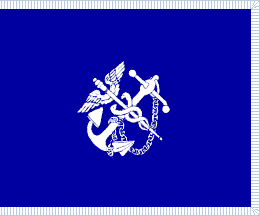
USSG Flag 2001
|
United States Surgeon General (Navy)
The Surgeon General's office and staff are known as the Office of the Surgeon General (OSG). The Surgeon General reports to the Assistant Secretary for Health (ASH), who may be a four-star admiral in the United States Public Health Service Commissioned Corps (PHSCC), and who serves as the principal advisor to the Secretary of Health and Human Services on public health and scientific issues. The Surgeon General is the overall head of the Public Health Service Commissioned Corps, a 6,000-member Commissioned Corps of the USPHS, a cadre of health professionals who are on call 24 hours a day, and can be dispatched by the Secretary of HHS or the Assistant Secretary for Health in the event of a public health emergency.
The Surgeon General is normally equivalent to a vice admiral, but, if serving concurrently as Assistant Secretary for Health, holds four-star rank. Either way, the SG's flag is blue with a white PHS corps device centered on it.
|
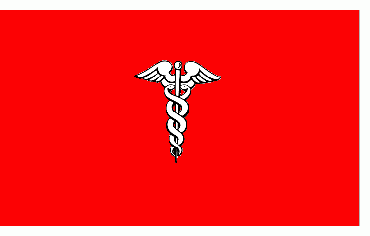
USSG Flag
|
Flag of the Army Surgeon General
The Surgeon General is normally equivalent to a ?? General, but, if serving concurrently as Assistant Secretary for Health, holds four-star rank. Either way, the SG's flag is blue with a white PHS corps device centered on it. Please note that this should not be confused with the Staff of Asclepius, which has only one snake on an unadorned staff and is symbolic of the medical profession.
|
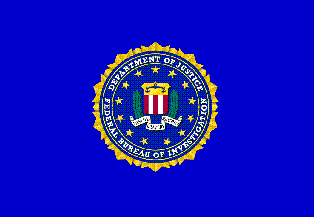
FBI Flag
|
Federal Bureau of Investigation
The agency was established in 1908 as the Bureau of Investigation (BOI). Its name was changed to the Federal Bureau of Investigation (FBI) in 1935. The mission of the FBI is to protect and defend the United States against terrorist and foreign intelligence threats, to uphold and enforce the criminal laws of the United States, and to provide leadership and criminal justice services to federal, state, municipal, and international agencies and partners. As the governmental agency (part of the United States Department of Justice) it serves as both a federal criminal investigative body and an internal intelligence agency (counterintelligence).
|
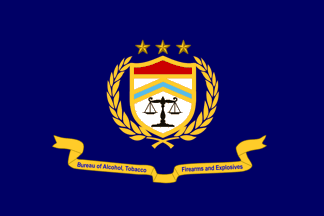
ATF Flag (to 2003)
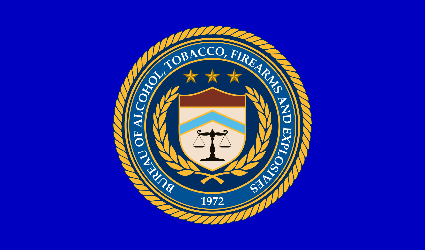
BATFE Flag (since 2003)
|
Bureau of Alcohol, Tobacco and Firearms
The history of Bureau of Alcohol, Tobacco and Firearms (ATF) can be traced to back the time of the "revenuers" and the Bureau of Prohibition, which was formed as a unit of the Bureau of Internal Revenue in 1920, was made an independent agency within the Treasury Department in 1927, transferred to the Justice Department in 1930, and became, briefly, a division of the FBI in 1933. When the Volstead Act was repealed in December 1933, the Unit was transferred from the Department of Justice back to the Department of the Treasury where it became the Alcohol Tax Unit of the Bureau of Internal Revenue. Made famous by Special Agent Eliot Ness and "The Untouchables," a special team of invesitators working for the Prohibition Bureau while the Volstead Act was still in force, were transferred to the ATU. In 1942, responsibility for enforcing federal firearms laws was given to the ATU.
The Bureau of Alcohol, Tobacco, Firearms and Explosives (ATF) is a federal law enforcement organization under the United States Department of Justice. The Bureau's responsibilities include the investigation and prevention of federal offenses involving the unlawful use, manufacture, and possession of firearms and explosives; acts of arson and bombings; and illegal trafficking of alcohol and tobacco products.
The ATF also regulates the sale, possession, and transportation of firearms, ammunition, and explosives in interstate commerce.
|
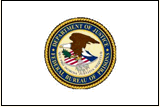
BOP Flag
|
Federal Bureau of Prisons
The Federal Bureau of Prisons (BOP) is a federal law enforcement agency and subdivision of the United States Department of Justice. It is responsible for the administration of the federal prison system. The system also handles prisoners who committed acts considered felonies under the District of Columbia's law.
The Bureau was established in 1930 "to provide more progressive and humane care for federal inmates, to professionalize the prison service, and to ensure consistent and centralized administration of the 11 federal prisons in operation at the time."
|
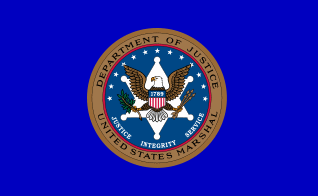
USMS Flag
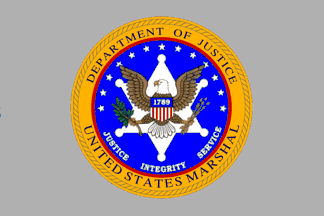
USMS Flag variant
|
United States Marshals Service
The United States Marshals Service (USMS) is a federal law enforcement agency under the direction of the United States Department of Justice. The U.S. Marshal Service is the second oldest federal law enforcement agency in the United States (second to the U.S. Customs Service) and was created in 1789. It assumed its current name in 1969.
The Marshals Service is part of the executive branch of government and is the enforcement arm of the United States federal courts. The U.S. Marshals are responsible for the protection of court officers and buildings and the effective operation of the judiciary. The service also assists with court security and prisoner transport, serves arrest warrants, and seeks fugitives.
Although the official flag of the United States Marshal Service normally shows the seal of the USMS centered on a blue flag, recently, there have been reports of a version of this flag being used with a grey background.
|
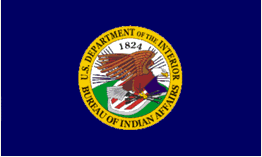
BIA Flag
|
Bureau of Indian Affairs
The Bureau of Indian Affairs (BIA) is an agency of the federal government of the United States within the US Department of the Interior. It is responsible for the administration and management of the land held in trust by the United States for Native Americans in the United States, Native American Tribes and Alaska Natives. The BIA’s responsibilities once included providing health care services, but in 1954, that function was transferred to the U.S. Department of Health, Education and Welfare where it has remained to this day as the Indian Health Service (IHS).
The Bureau of Indian Affairs is one of two bureaus under the jurisdiction of the Assistant Secretary-Indian Affairs and provides education services to approximately 48,000 Native Americans.
|
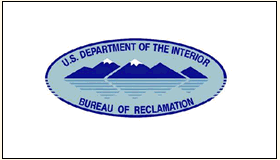
USBR Flag
|
Bureau of Reclamation
The United States Bureau of Reclamation (USBR), formerly known as the United States Reclamation Service, is an agency under the U.S. Department of the Interior, which oversees water resource management, specifically as it applies to the oversight and/or operation of numerous diversion, delivery, and storage projects it built throughout the western United States for irrigation, water supply, and attendant hydroelectric power generation.
Currently the United States Bureau of Reclamation is the largest wholesaler of water in the country, bringing water to more than 31 million people, and providing one in five Western farmers with irrigation water for 10 million acres of farmland, which produce 60% of the nation's vegetables and 25% of its fruits and nuts. The United States Bureau of Reclamation is also the second largest producer of hydroelectric power in the western United States.
|
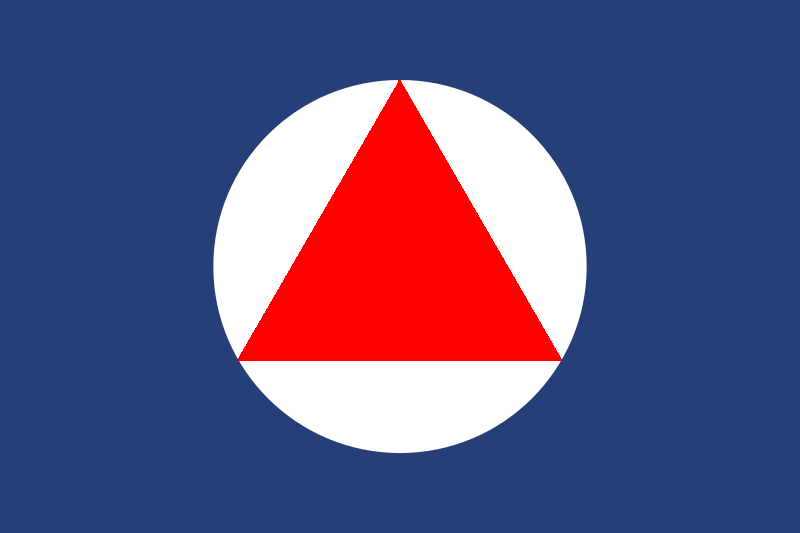
USC&GS Flag
|
United States Coast and Geodetic Survey 1899-1970
The National Geodetic Survey, was our Nation's first civilian scientific agency, and established by President Thomas Jefferson in 1807 as the Survey of the Coast. Its mission was, and still is, to survey the U.S. coastline and create nautical charts of the coast to help increase maritime safety. As the nation grew westward surveys of the U.S. interior began. In 1878, the agency was given a new name, the U.S. Coast and Geodetic Survey, which it maintained until 1970.
In 1970, a reorganization created the National Oceanic and Atmospheric Administration (NOAA) and the National Ocean Service (NOS) was created as a line office of NOAA. To acknowledge the geodetic portion of NOAA mission, the part of NOS responsible for geodetic functions was named the National Geodetic Survey.
|
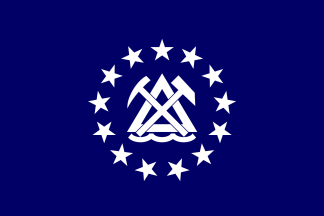
CGS Flag
|
United States Geological Survey 1970
The U.S. Geological Survey is a bureau of the Department of the Interior which, among other things, operates a small fleet of research vessels on both coasts and the Great Lakes. These ships conduct geophysical, limnological, biological, and mineralogical research.
The USGS flag, adopted in 1906, comes in two sizes, two by three feet for display from halyards (as shown) and 52 by 66 inch (with fringe, cord, and tassels) for indoor and ceremonial use.
|
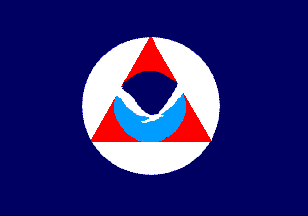
NOAA Flag
|
National Oceanic and Atmospheric Administration
The National Oceanic and Atmospheric Administration (NOAA), is a scientific agency within the United States Department of Commerce focusing on the conditions of the oceans and the atmosphere. NOAA warns of dangerous weather, charts seas and skies, guides the use and protection of ocean and coastal resources, and conducts research to improve understanding and stewardship of the environment.
In addition to its civilian employees, NOAA research and operations are supported by 300 uniformed service members who make up the NOAA Commissioned Officer Corps led by the Under Secretary of Commerce for Oceans and Atmosphere at the Department of Commerce.
|
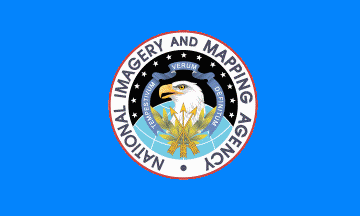
NIMA Flag
|
National Imagery and Mapping Agency
The National Geospatial-Intelligence Agency (NGA) is an agency of the federal government of the United States with the primary mission of collecting, analyzing, and distributing geospatial intelligence (GEOINT) in support of national security. NGA was formerly known as the National Imagery and Mapping Agency (NIMA) and is part of the Department of Defense (DoD). In addition, NGA is a key component of the United States Intelligence Community.
The National Geospatial-Intelligence Agency headquarters is located in Springfield, Virginia and operates major facilities in the St. Louis, Missouri area, as well as support and liaison offices worldwide.
|

FAA Flag
|
Federal Aviation Administration
The Federal Aviation Administration (FAA) is the national aviation authority of the United States. An agency of the United States Department of Transportation, it has authority to regulate and oversee all aspects of civil aviation in the U.S. The Federal Aviation Act of 1958 created the organization under the name "Federal Aviation Agency", and adopted its current name in 1966 when it became a part of the United States Department of Transportation.
|
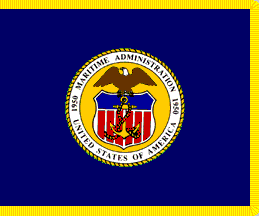
USMA Flag
|
United States Maritime Administration
The United States Maritime Administration (MARAD) is an agency of the United States Department of Transportation that maintains the National Defense Reserve Fleet (NDRF) as a ready source of ships for use during national emergencies, and assists the NDRF in fulfilling its role as the nation's fourth arm of defense, logistically supporting the military when needed. It is also the parent of the U.S. Merchant Marine.
The United States Maritime Administrator is also the Chairperson of the Maritime Subsidy Board, Commandant of the United States Maritime Service, and Director of the National Shipping Authority.
|
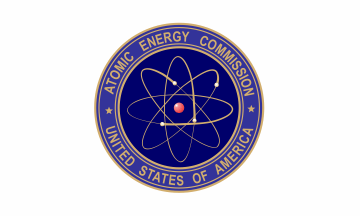
AEC Flag
|
United States Atomic Energy Commission 1946-1975
The United States Atomic Energy Commission (AEC) was an agency of the United States government established after World War II by Congress to foster and control the peace time development of atomic science and technology. President Harry S. Truman signed the McMahon/Atomic Energy Act in 1946, transferring the control of atomic energy from military to civilian hands.
An increasing number of critics during the 1960s charged that the AEC's regulations were insufficiently rigorous in several important areas, including radiation protection standards, nuclear reactor safety, plant siting, and environmental protection. By 1974, the AEC's regulatory programs had come under such strong attack that Congress decided to abolish the agency. The agency was broken into two by the Energy Reorganization Act of 1974, which assigned its functions to two new agencies: the Energy Research and Development Administration and the Nuclear Regulatory Commission.
|
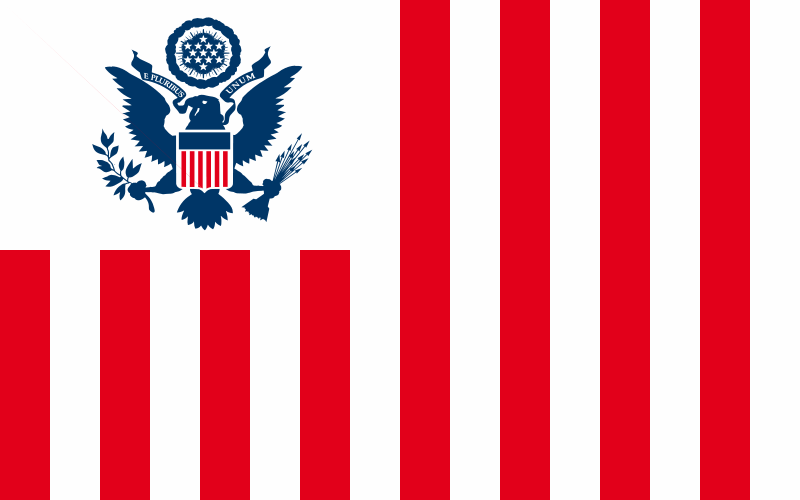
USCS Flag
|
United States Customs Service
The United States Customs Service was an agency of the United States government that collects import tariffs and performed other selected border security duties. In March of 2003, it was made part of the U.S. Department of Homeland Security as the Bureau of Customs and Border Protection and Immigration and Customs Enforcement.
The United States Customs Service historically had three major missions: collecting tariff revenue, protecting the U.S. economy from smuggling and illegal goods, and processing people and goods at ports of entry.
|
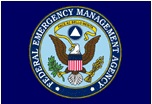
FEMA Flag
|
Federal Emergency Management Agency 1979-2003
The Federal Emergency Management Agency (FEMA) is an agency of the United States Department of Homeland Security, created in 1978 by two Executive Orders. The primary purpose of FEMA is to coordinate the response to a disaster that has occurred in the United States or territories of the United States, that overwhelms the resources of local and state authorities.
Usually the governor of the state or territory in which the disaster would declare a state of emergency and formally request from the president for FEMA and the federal government to respond to the disaster.
|
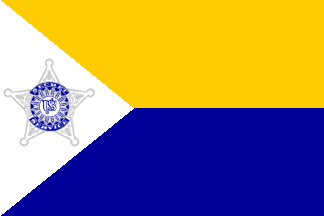
USSS Flag
|
United States Secret Service
The United States Secret Service is a United States federal law enforcement agency and part of the United States Department of Homeland Security. Members are divided among the Special Agents and the Uniformed Division. Until March 1, 2003, the Service had been part of the United States Department of the Treasury.
The U.S. Secret Service has two distinct areas of responsibility: Treasury and Protective. Its Treasury responsibilities include prevention and investigation of counterfeiting of U.S. currency and U.S treasury securities, and investigation of major fraud. Its Protective roles include ensuring the safety of current and former national leaders and their families, such as the President, past Presidents, Vice Presidents, presidential candidates, and foreign embassies. |
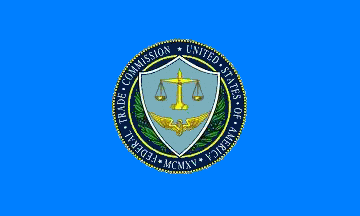
FTC Flag
|
Federal Trade Commission
The Federal Trade Commission (FTC) is an independent agency of the United States government, established in 1914 by the Federal Trade Commission Act. Its principal mission is the promotion of consumer protection and the elimination and prevention of what regulators perceive to be harmfully anti-competitive business practices.
The Federal Trade Commission Act was one of President Woodrow Wilson's major acts against trusts. Trusts and trust-busting were significant political concerns during the Progressive Era.
|
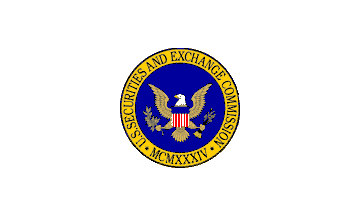
SEC Flag
|
Securities and Exchange Commission
The U.S. Securities and Exchange Commission (SEC) is a federal agency which holds primary responsibility for enforcing the federal securities laws and regulating the securities industry, the nation's stock and options exchanges, and other electronic securities markets in the United States.
In addition to the 1934 Act that created it, the SEC enforces the Securities Act of 1933, the Trust Indenture Act of 1939, the Investment Company Act of 1940, the Investment Advisers Act of 1940, the Sarbanes-Oxley Act of 2002 and other statutes.
|

NSF Flag
|
National Science Foundation
The National Science Foundation (NSF) is a United States government agency "that supports fundamental research and education in all the non-medical fields of science and engineering." Its medical counterpart is the National Institutes of Health. The NSF funds approximately 20% of all federally supported basic research conducted by the United States' colleges and universities.
The NSF's director, deputy director, and the members of the National Science Board (NSB) are appointed by the President of the United States, and confirmed by the United States Senate. The director and deputy director are responsible for administration, planning, budgeting and day-to-day operations of the foundation, while the NSB meets six times a year to establish its overall policies.
|
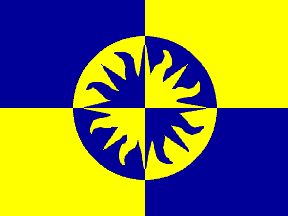
SI Flag
|
Flag of the Smithsonian Institution
The Smithsonian Institution, best known as the parent organization of the U.S. national museums on the Mall in Washington, is also a premier scientific research institution. It operates a number of maritime-related research centers, including the Smithsonian Tropical Research Institute in Panama, the Smithsonian Marine Station in Fort Pierce, Florida, and the Smithsonian Environmental Research Center in Edgewater, Maryland, on the Chesapeake Bay. Each of these centers operates a number of small to medium-size research vessels.
The Institution flag shown was formerly displayed at Smithsonian facilities from the headquarters at "The Castle" in Washington to the outlying field activities. It showed the sun of knowledge on a circle representing the globe, counterchanged on a quarterly blue and yellow field. It has unfortunately been replaced in recent years by a white flag with the Institution logo (yellow sun on blue disk).
|
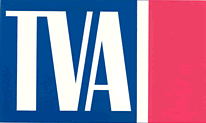
TVA Flag
|
Flag of the Tennessee Valley Authority
The Tennessee Valley Authority was created in 1933 as a project to control the devastating seasonal floods of the Tennessee River and its tributaries and to generate hydroelectric power to meets the underdeveloped region's energy needs. Its navigational responsibilities include the maintenance of a nine-foot channel on the Tennessee River from Paducah, Kentucky, to Knoxville, Tennessee, as well as the operation of a sprawling network of locks and dams. It is also the principal electric power provider to most of Tennessee, large portions of Kentucky, Mississippi, and Alabama, and smaller areas of Georgia and North Carolina.
The TVA Flag was designed on commission by Dr. Whitney Smith and can be seen on many of its installations.
|
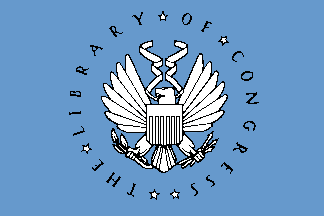
LOC Flag
|
United States Library of Congress
The Library of Congress is the national library of the United States and research library of the United States Congress. It is one of the oldest federal institutions in the United States with its main branch located near the national mall in Washington, D.C. It is one of the largest library in the world.
The Library of Congress was built for Congress in 1800, but although much of its original collection of books were destroyed during the War of 1812, Thomas Jefferson sold 6,487 books, his entire personal collection, to the library in 1815. From that point the Library of Congress began to slowly grow in both size and importance, especially after the American Civil War, culminating in the construction of its four separate library buildings to house its main collection.
|
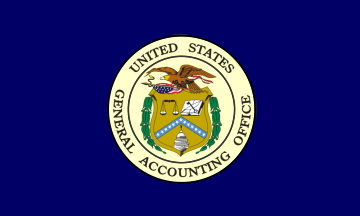
GAO Flag 1921-2004
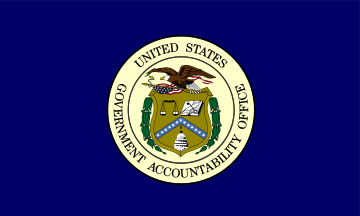
GAO Flag after 2004
|
United States General Accounting Office
The Government Accountability Office (GAO) audits, evaluates, and investigatates the finaces of the United States government for the United States Congress and legislature.
The GAO was first established as the General Accounting Office by the Budget and Accounting Act of 1921. The head of General Accounting Office was charged to "investigate, at the seat of government or elsewhere, all matters relating to the receipt, disbursement, and application of public funds, and shall make to the President...and to Congress...reports [and] recommendations looking to greater economy or efficiency in public expenditures."
The flag of the General Accounting Office was a typical government design simply centering the General Accounting Office seal on a navy blue flag. The General Accounting Office was renamed in 2004 the Government Accountability Office, hence a new seal (basically the same design with new wording surrounding the seal), and a new government flag was created using the standard established pattern. |
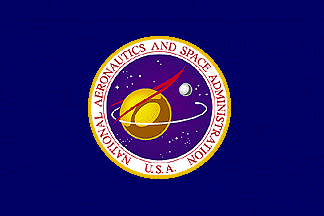
NASA Flag
|
National Aeronautics and Space Administration
The National Aeronautics and Space Administration (NASA) is the agency of the United States government responsible for the United States civilian space program. Originally founded in 1958 by the National Aeronautics and Space Act, NASA replaced its predecessor, the National Advisory Committee for Aeronautics (NACA). However recent budget cuts have seriously hamptered NASA's stated mission to "pioneer the future in space exploration, scientific discovery and aeronautics research," and many major programs have been reduced or closed down completely, including the sucessful Space Shuttle program and moon exploration.
Many feel that the future of the organization is in question, although, in 2011, NASA did announce that it had selected the design of a new Space Launch System which it hoped would lead to future human space exploration by the United States.
|
Flags of the Legislative Branch
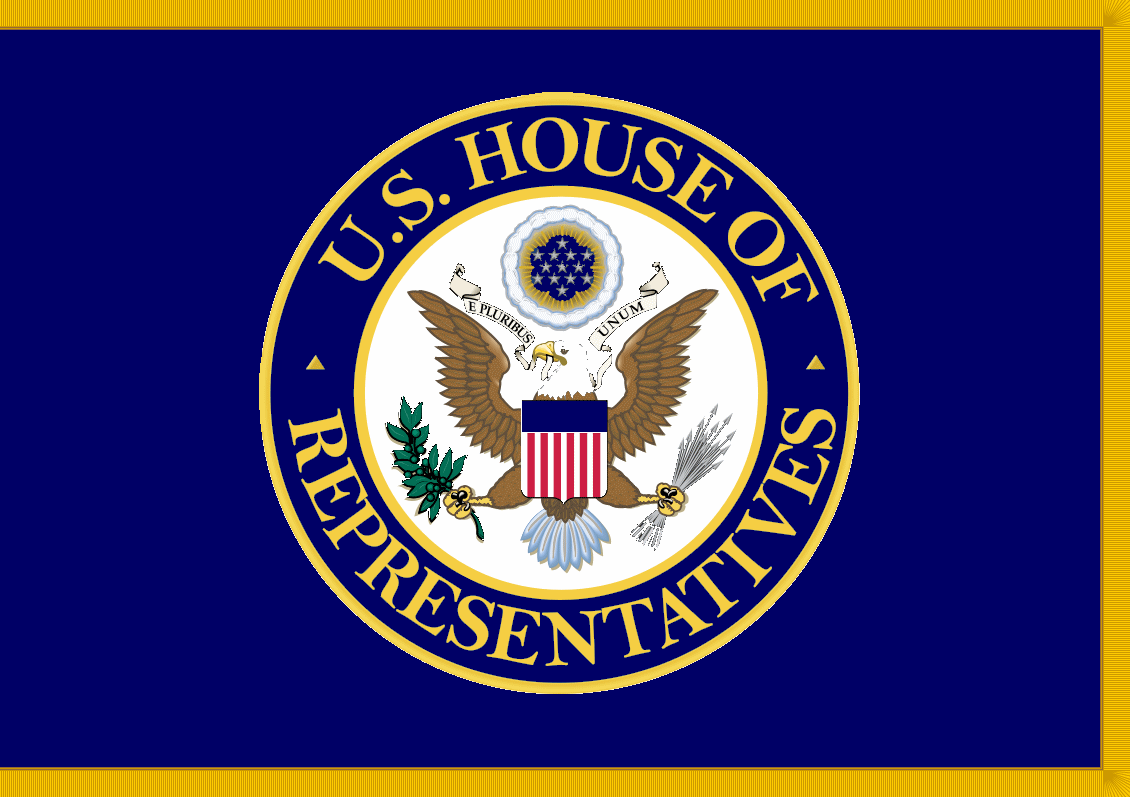
US House Flag
(de facto version)

US House Flag
(variant version)
|
United States House of Representatives
In the strange world of political double talk there is no flag of the United States House of Representatives, but, in fact, it not only exists, there are several versions in use. The problem is apparently no official documentation for an "official" flag for the House of Representatives has ever been authorized or produced, and in a classic case of "one hand not knowing what the other is doing," several different legislative departments have had versions of the flag made.
There was an unsuccessful effort to officially authorize a House flag and pennant in 1961, and in 1984 there was legislation introduced prohibiting "former" members of Congress to display a flag indicating current service, but again the actual description for said flag is missing.
The Office of the Clerk of the U.S. House of Representatives, whose job is to see that the chamber's records are properly prepared and preserved, including photo and video records, have to make sure a proper stage is set. Apparently they use a House flag that has the House seal on a white field, fringed in gold. Two such flags were reportedly ordered and custom-made at a cost of $900 each, but no documentation for the authorization of this flag design or any other official description of it exists.
Then the Speaker's Office itself probably had several flags made to use for special press conferences in the Capitol building when the Speaker was using a room to speak, and they likely are the ones who created the blue flag with the House seal and gold fringe we see in many phonographs of the current Speaker of the House. So basically, the flag exists de facto, if not de jure.
|
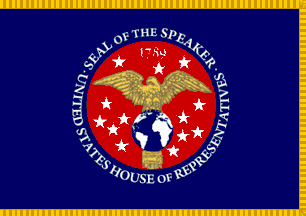
SHOR Flag
(un-official de facto)
|
Speaker of the House of Representatives
The Speaker of the House is the presiding officer of the United States House of Representatives. The office was established in 1789. Strangely enough, the Constitution does not require that the Speaker be a member of Congress, however, in reality no non-member has ever been elected or is likely to be. The Speaker is actually chosen by the majority party in the House (since they control the vote) and actively works to support that party's legislative platform. The Speaker is second in the United States presidential line of succession, after the Vice President, giving the office considerable power.
The flag currently in use for the Speaker of the House has his seal centered on a blue field with a gold fringe. Again, no documented authorization exists for this de facto flag.
|
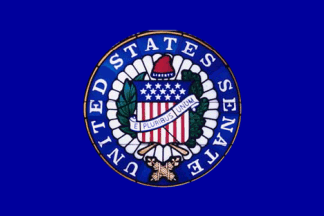
US Senate Flag (official)

US Senate Flag (unofficial)
|
United States Senate
The United States Senate is the upper house of the bicameral (two-housed) United States Congress and together with the United States House of Representatives make up the legislature of the United States. Each state in the United States is represented by two senators in the Senate. Senators serve six-year terms, with half up for election every three years. The United States Senate chamber is located in the north wing of the Capitol building in Washington, D.C. with the House of Representatives located opposite the Senate chambers in the south wing of the same building.
The Senate created its official flag in March 1988, four years after it was proposed by Senator Daniel Inouye. In April 1985, the Committee on Rules and Administration invited eight flag manufacturers to submit designs. A year and a half later, the committee chose the design proposed by the Army's Institute of Heraldry, a navy blue banner emblazoned with the Liberty Cap Senate seal.
Strangely enough, the Senate seems to have two versions of their flag, one with the official "Liberty Cap" Seal, and another "unofficial"" one reported using a more generic "Eagle Seal" (while the House of Representatives barely has one). Use of this second seal on a flag is undocumented, however.
|
|